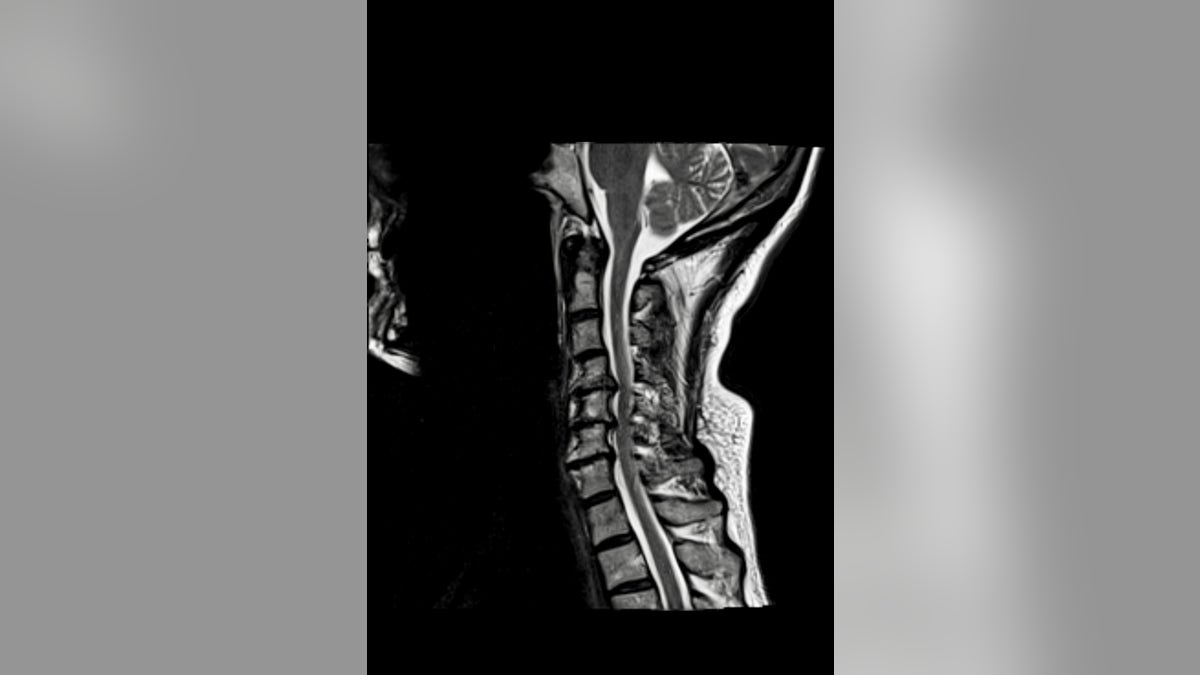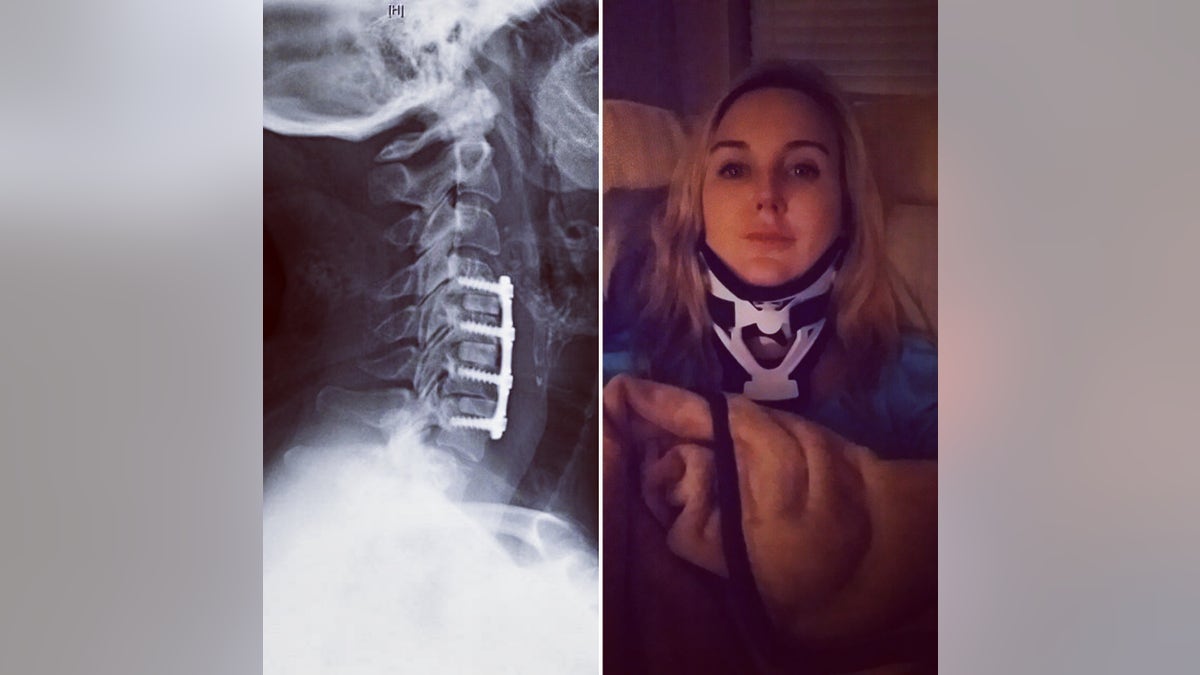
Heather Childers is visited by a friend while recovering after surgery at New York Presbyterian Columbia Medical Center in July (Courtesy of the author)
If you get up very, very early you may have seen me weekday mornings on “Fox & Friends First" since the show launched on Fox News Channel in 2012. I've been away from my job as 4 a.m. to 5 a.m. host on the show since July 13, but I’m very happy to be returning Tuesday – after a shocking medical emergency and surgery to avoid being paralyzed for the rest of my life.
I want to share my story with all of you reading this, along with my TV audience, because I want you to learn from a big mistake I made. I ignored warnings signs my body was sending me saying something was wrong. I won’t do that again – and hope none of you will do that either.
Take it from me: ignoring a health problem won’t make it go away. Don't make excuses when you are dealing with real physical symptoms, or wait for a medical emergency before you see a doctor.

The author's cervical spine before surgery showing spinal cord compression in three areas. (Courtesy of the author)
I never wanted to take sick days from work because I was always worried it would impact my job, especially since a lot of what I was experiencing was happening while management, schedule and talent changes were happening at Fox News.
But I had no choice when my medical problem turned into a crisis in early July while I was hosting “Fox & Friends First.” Shooting pains started ricocheting through the right side of my head. I made it through the show and went home immediately afterward, hoping my ferocious headache would go away.
Take it from me: ignoring a health problem won’t make it go away. Don't make excuses when you are dealing with real physical symptoms, or wait for a medical emergency before you see a doctor.
The next day, thinking I was better, I went back to work and it happened again – only worse. Again, I went immediately home, hoping the terrible pain would go away. It didn’t – for four long days.
I went in to the hospital for an MRI of my brain. Thankfully, I saw an outstanding neurologist – Dr. Ludmilla Bronfin. During my initial exam, she also tested my reflexes and discovered they were overactive – a condition called hyperreflexia, which can be caused by a variety of conditions. As a result, she ordered an MRI not only of my brain, but also of my neck.
Then Dr. Bronfin gave me frightening news and told me I had a medical condition I’d never even heard of.
“There’s a 100 percent chance you won’t be walking when you are older,” the doctor said. “You could hit a pothole the wrong way and be paralyzed right now."
What? Paralyzed? What was wrong with me?
Dr. Bronfin told me there was nothing wrong with my brain – wonderful news! But the doctor said I had a serious problem with my spine – something called cervical spinal stenosis with myelopathy. In plain English, that means my spinal cord was being dangerously compressed in my neck.
Dr. Bronfin told me I needed surgery as soon as possible to keep things from getting any worse, so I wouldn’t eventually become paralyzed because of spinal cord compression.
Turns out that the compression of my spine began years ago when I was in a car wreck as a 16-year-old, resulting in traumatic injuries to my head and neck. I didn’t know it, but the trauma to my neck had apparently slowly been getting worse and worse over the years. I never even thought about my neck, and as a result, I ignored some very key warning signs.
In the year prior to my surgery, I had been experiencing moments when my legs felt numb – not a tingly-numb, but a dead and heavy numb feeling where I would beat my legs to try to make the feeling come back. Other times, I experienced shooting pains and cramping in my legs. Every time it happened I had an excuse. I blamed it on low potassium, lack of sleep (I start work at 1 a.m.), or stress.
I had been diagnosed with low iron and vitamin D deficiency. I was also experiencing issues with bowel control – I’ll spare you the details. And I was having shooting pains in my arms.
I actually went to an emergency room one time because I thought I was having a heart attack after anchoring all-night coverage during the presidential debates. I was told there was nothing wrong with my heart so I went right back to work for our next night of coverage. I blamed the pains in my arms on too much caffeine and lack of sleep.

Heather and her dad recovering at home in North Carolina. (Courtesy of the author)
Fast forward to this past April. I covered a story at Fort Bragg, where I rappelled down a 45-foot wall. At the time, I couldn’t physically turn my neck to look down no matter how hard I tried to force it. I had experienced a “stiff neck” for years. I had blamed it – again – on stress, lack of sleep, or other little things. I considered this a nuisance, not a serious health issue.
As for this particular incident at Fort Bragg – I just blamed it on being terrified 45 feet up in the air! But after this incident, what had previously been sporadic bouts of numb legs turned into flat-out falling down, with my right leg dragging. My arms began to have the same weak feeling as my legs, where I could barely raise them long enough to wash my hair.
My hands had begun to ache. I had begun to drop things, like my all-important coffee in the morning! Still, in my mind, I had excuses for everything – and I never thought that all my problems were related. Thanks to Dr. Bronfin, I now know that all my problems were the result of my spinal cord being compressed in my neck.
After my MRI, I consulted with four different neurosurgeons in person and three others looked at my MRI results remotely. They all said the same thing, I needed surgery – and I needed it soon. Cervical spinal stenosis with myelopathy isn’t curable, but surgery can stop symptoms from progressing. And my symptoms were progressing all too rapidly.
I was very lucky to have one of the very best neurosurgeons, Dr. Paul McCormick with the Spine Center at Columbia University Medical Center in New York City.

An image following after surgery showing titanium plate, screws and implants from bone bank (Courtesy of the author)
The surgery itself involved three areas of my spine in my neck. The affected discs and bone spurs were removed from an incision in the front of my neck. Dr. McCormick then fused together the open spaces between the vertebrae by implanting a bone graft from a bone bank and then secured everything together with a titanium metal plate and screws.
I was fitted with a neck brace and have worn it nonstop since the surgery July 13 – shower and sleep included!
I was warned I might have problems with my voice after surgery, but aside from a cough for a couple weeks, my voice is back to normal. I was also back up and walking almost immediately, albeit very slowly!
I am now up to walking two miles in about 90 minutes. For someone who loves to rollerblade, run, bike, golf and engage in other athletic activity, it has been a bit frustrating to take things so slowly – but I know patience is key. It will take about a year to fully fuse everything together.
I am now up to walking two miles in about 90 minutes. For someone who loves to rollerblade, run, bike, golf and engage in other athletic activity, it has been a bit frustrating to take things so slowly – but I know patience is key. It will take about a year to fully fuse everything together.
The biggest blessing in all this has been that after a stay in the hospital I was able to travel to North Carolina to recover at home with my parents.
While I was recovering, my dad was finishing up radiation treatments for prostate cancer. He was diagnosed a year ago, about the same time all of this started with me. It has been quite a year.
I can't say thank you enough to Dr. Paul McCormick and the entire surgical and recovery team at Columbia University Medical Center and Presbyterian Hospital. Thank you as well to Dr. Ludmilla Bronfin.
And I want to thank Dr. Marc Siegel, a professor of medicine and internist at the New York University Langone Medical Center who – fortunately for me – is also a medical analyst and reporter for Fox News. He helped me every step of the way and without him I couldn’t have ended up with such a great medical team.
Also, thank you to my mother, sister and boyfriend who came to New York to be with me through the surgery and the immediate days afterward. My mother gets double thanks for continuing to take care of me and my dad while we both recovered at home in North Carolina.
Finally, thank you to all of the Fox News viewers who have reached out to me the past few weeks with kind words and who have told me they prayed for my recovery. You are so kind and thoughtful. And now your prayers have been answered and am back at Fox News! God bless you all.
By the time many of you read this – if it’s after 5 a.m. ET Tuesday – I will have wrapped up my return on “Fox & Friends First.” I look forward to many, many more early mornings with my friends on the show and with our wonderful viewers.
